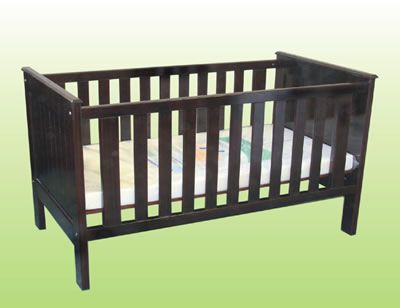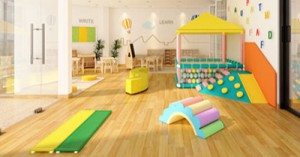Cots are baby beds with four raised sides, usually with one moveable side that may be released and dropped down, thereby lessening the difficulty of babies being placed in and taken out of cots.
Cot mattresses are designed specifically for use in cots and hence are thinner and smaller than the average mattress. Mattresses vary in size in order to fit a range of cot sizes, therefore the fit of a mattress within a cot is a very important safety consideration.
How may children be injured when sleeping in cots and using cot mattresses?
Entrapment
- Babies may get their heads caught in the space between vertical cot bars.
- Babies may get their arms, legs, fingers and/or toes caught in cot gaps.
Falls
- Babies may fall out of the cot if they are able to climb over one of the cot edges. Cot sides may serve as ladders if the mattress in the cot is too high, if your baby has objects such as soft toys in the cot to climb upon, or if the cot has horizontal bars on the frame.
- Babies may fall through vertical cot bars if the gaps are too wide.
Strangulation
A baby’s clothing may become caught on protruding parts of the cot, creating a potentially fatal strangulation hazard for the baby.
Suffocation
- Babies may become trapped between the mattress and cot frame if the mattress does not fit snugly inside the cot.
- Babies may suffocate if items such as toys, head bumpers and pillows placed in the cot prevent them from breathing.
- Babies may suffocate under bed linen, if the bed is made up incorrectly. Loose bedclothes may be pulled up over a baby’s face.
How common are these injuries?
Of the injuries due to nursery furniture seen at the Children’s Hospital at Westmead Emergency Department in 2004, 21% were related to cots. The main cause of injury due to cots was babies falling out of them, which accounted for more than 50% of injuries relating to cots.
Is there a Law or an Australian Standard for cots and cot mattresses?
The law states that all cots sold in Australia must comply with the Australian Standard (AS/NZS 2172-2010). These standards relate to the distance between the mattress and the lowest side of cots, for falls prevention; the minimum and maximum gap sizes, to prevent entrapment; and the maximum height protrusions to prevent strangulation. Mandatory specifications include the following:
- Spaces between vertical bars must measure between 5cm and 9.5cm in width in order to prevent head entrapment.
- There should not be any gaps in the cot that measure between 3cm and 5cm in width, in order to prevent arm or leg entrapment.
- There should not be any gaps in the cot that measure between 5mm and 12mm in width, in order to prevent finger and toe entrapment.
- The distance between the top of the mattress and the top of the cot sides should be at least 60cm.
- The inside of the cot must be free from horizontal bars or other features that may allow your baby to climb over the side of the cot.
- There should be no protruding parts or screws that clothing may get caught on. Protrusions must not measure more than 5mm and bolts must not measure more than 5mm in height.
Remember
- The Children’s Hospital at Westmead recommends that you purchase a cot that meets the Australian Standards (AS2172).
- Check that the side of the cot that is able to be released is held by child safety latches, which prevent children from unlatching them.
- Check that the mattress fits snugly inside the cot. The gap between a cot and its mattress should not measure more than 2cm when the mattress is centered in the cot base.
- If you choose to use a second hand mattress, check that it fits snugly inside the cot and is firm, clean and in good condition.
- Place the cot away from windows that have cord or blind strings close by. These strings may pose a strangulation hazard if your baby can access them from the cot.
- Place the cot away from heaters, lights, power points and electrical appliances to ensure that your baby does not get burned.
- Do not place pillows, bumpers, comforters or sheepskins in the cot, especially when you place your baby in the cot.
- Make sure that the cot sheets fit snugly around the mattress with the sheets folded under the mattress so that they may not be dislodged when pulled on one side.
- Regularly check that the cot is free from wear and tear, particularly the edges and locking mechanisms.
- Place your baby on his or her back to sleep and make up the cot so that his or her feet are at the end of the cot (for more information visit www.sidsandkids.org).
The Children’s Hospital at Westmead recommends that you check for products that have been recalled (www.recalls.gov.au) prior to buying or borrowing an item for use with your child.
References
Aussie Childcare Network acknowledges the co-operation of The Children’s Hospital at Westmead, Sydney Children’s Hospital and Kaleidoscope, Hunter Children’s Health Network in making this fact sheet available.
Disclaimer: This article is for education purposes only. Please consult with your doctor or other health professional to make sure this information is right for your child.










